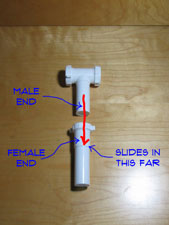 Their is a certain order that should be followed for assembling sink drain pipes. Tail pieces or waste outlets should be hooked up first. The outlet for the trap should go into the wall next. The tee (for a kitchen sink) should go in next.
Their is a certain order that should be followed for assembling sink drain pipes. Tail pieces or waste outlets should be hooked up first. The outlet for the trap should go into the wall next. The tee (for a kitchen sink) should go in next.
Usually the last item would be the "J" for the trap. For a double kitchen sink you would want to put the tailpiece and waste arm on one side, then the tee and then the tailpiece and waste arm on the other side.
For a bathroom sink you start with the tailpiece/pop up assembly. Next would be the outlet that goes in the wall. Lastly the "J" for the trap.
Most of the time it is self explanatory. Even if you get them out of order, it is not a big deal to back up and redo them. Assembling sink drain pipes is one of the easier plumbing projects.
Put everything in hand tight to make sure it all fits. Snug up the fittings and check the alignment of everything. Once you are sure that everything is fitting you can tighten the nuts.
For plastic fittings they say hand tight is good enough. I usually don't trust that and go about a quarter to a half turn past hand tight with the adjustable pliers. Metal nuts may require a full turn or two past hand tight. There is some give in these types of fittings. So don't tighten them with a torque wrench.
The concepts are similar for replacing a single piece. Try to keep from disturbing the other pieces when you tighten the new one. Aggravating when you fix one leak and create two others.
Cutting

Cutting sink drain pipes is not difficult. Especially if you go with the less expensive pvc plastic pipes.
Notice the fittings fit inside one another. So the fittings that slip together have either a male or female end. No explanation on that on, you can figure it out. Some ends are threaded to mate up with a matching piece, like the P Trap.
Due to this feature you will have to allow for the overlap when you measure your pieces. You can tell on the outside of the female piece how far in the other piece will slide in. Mark the piece you are cutting accordingly.
Your use a hack saw to cut the pipe whether it is metal or plastic. The cuts do not have to be perfect due to the overlap. Dry fit the pieces to make sure the are fitting correctly. The piece of drain pipe that goes into the wall will also be cut long. It will go inside the pipe a couple of inches and be held in place by the nut and washer.
Assembling
Their is a certain order that should be followed for assembling sink drain pipes. Tail pieces or waste outlets should be hooked up first. The outlet for the trap should go into the wall next. The tee (for a kitchen sink) should go in next.
Usually the last item would be the "J" for the trap. For a double kitchen sink you would want to put the tailpiece and waste arm on one side, then the tee and then the tailpiece and waste arm on the other side.
For a bathroom sink you start with the tailpiece/pop up assembly. Next would be the outlet that goes in the wall. Lastly the "J" for the trap.
Most of the time it is self explanatory. Even if you get them out of order, it is not a big deal to back up and redo them. Assembling sink drain pipes is one of the easier plumbing projects.
Put everything in hand tight to make sure it all fits. Snug up the fittings and check the alignment of everything. Once you are sure that everything is fitting you can tighten the nuts.
For plastic fittings they say hand tight is good enough. I usually don't trust that and go about a quarter to a half turn past hand tight with the adjustable pliers. Metal nuts may require a full turn or two past hand tight. There is some give in these types of fittings. So don't tighten them with a torque wrench.
The concepts are similar for replacing a single piece. Try to keep from disturbing the other pieces when you tighten the new one. Aggravating when you fix one leak and create two others.

